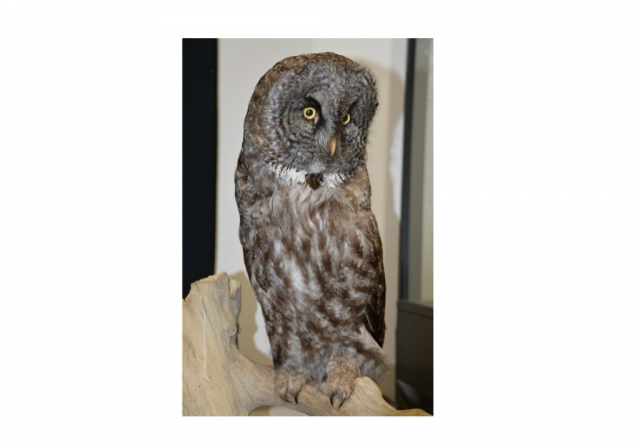Strix nebulosa
Status: Rare casual winter visitor.
Documentation: Specimen: HMM 2537, collected winter 1912 Columbus, Platte Co
Taxonomy: Two subspecies are recognized, one each in Eurasia and North America; nebulosa occurs in North America (AviList 2025).
The Nebraska records are presumed nebulosa.
Record: There are two records.
winter 1912, Columbus, Platte Co (cited above)
1 Jan 1978 Dixon, Dixon Co; mount at WSC.
The 1912 specimen is one of two killed in winter 1912 near Columbus, Platte Co; the specimen was mounted by J.E. Wallace at the Northwest School of Taxidermy in Omaha in 1912 and purchased by A.M. Brooking for the HMM collection prior to 1926 and is now HMM #2537 (Jessica Nordway, HMM Registrar, personal communication).
The Dixon Co record is of a bird first seen 31 Dec 1977 and illegally shot 1 Jan 1978 near Dixon; it was a female in underweight condition (Lock 1978, Mollhoff 1979).
There are additional undocumented reports. One reported near Omaha, Douglas Co 17 Dec 1893 by Trostler (Bruner et al 1904). Two were said to have been shot about 1896 near Maywood, Frontier Co, and exhibited there for some time (Brookings Notes, Bray et al 1986). According to Bruner et al (1904), a mounted specimen in a saloon at Long Pine, Brown Co was said to have been taken in the vicinity.
Comments: This species is resident in northwest Wyoming (Faulkner 2010) and northeastern Minnesota (Minnesota Breeding Bird Atlas 2017). There are no records for Colorado, Kansas, or Missouri (eBird.org, accessed Oct 2023), and only three from South Dakota, all during Jan-Mar (Tallman et al 2002). There are at least 15 records for Iowa Dec-May; as many as three were present during winter 1995-96 and two in winter 1996-97 (IOURC). The winter of 1995-96 was the most recent of a few large invasions since that of 1968-69, including 1977-78, when the Nebraska bird appeared (Mollhoff 1979), and 1983-84, when the first South Dakota bird appeared (Kent and Dinsmore 1996). In Minnesota, the probable source of Nebraska and Iowa birds, fall movement becomes noticeable some years in Oct, sometimes developing into invasions, with most birds departing by mid-Mar (Janssen 1987). However, even in Minnesota the species is “accidental” in the south (Janssen 1987).
Images
Abbreviations
HMM: Hastings Municipal Museum
WSC: Wayne State College
Literature Cited
AviList Core Team, 2025. AviList: The Global Avian Checklist, v2025. https://doi.org/10.2173/avilist.v2025.
Brooking, A.M. Notes. Bird specimen records. Manuscript in NOU Archives, University of Nebraska State Museum, Lincoln, Nebraska, USA.
Bruner, L., R.H. Wolcott, and M.H. Swenk. 1904. A preliminary review of the birds of Nebraska, with synopses. Klopp and Bartlett, Omaha, Nebraska, USA.
Faulkner, D.W. 2010. Birds of Wyoming. Roberts and Company, Greenwood Village, Colorado, USA.
Janssen, R.B. 1967. Birds in Minnesota. University of Minnesota Press, Minneapolis, Minnesota, USA.
Kent, T.H., and J.J. Dinsmore. 1996. Birds in Iowa. Publshed by the authors, Iowa City and Ames, Iowa, USA.
Lock, R.A. 1978. A second Great Gray Owl record from Nebraska, and other recent owl records. NBR 46: 16.
Minnesota Breeding Bird Atlas. 2017. Great Gray Owl (Strix nebulosi), accessed 23 May 2018.
Mollhoff, W.J. 1979. Great Gray Owl distribution, winter 1977-78. NBR 47: 62-65.
Tallman, D.A., Swanson, D.L., and J.S. Palmer. 2002. Birds of South Dakota. Midstates/Quality Quick Print, Aberdeen, South Dakota, USA.
Recommended Citation
Silcock, W.R., and J.G. Jorgensen. 2025. Great Gray Owl (Strix nebulosa). In Birds of Nebraska — Online. www.BirdsofNebraska.org
Birds of Nebraska – Online
Updated 14 Jul 2025

